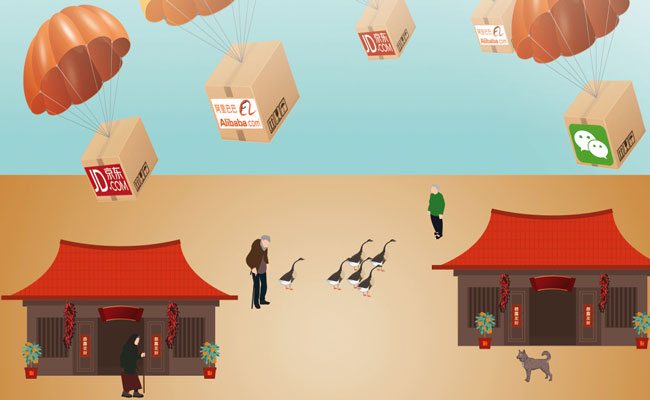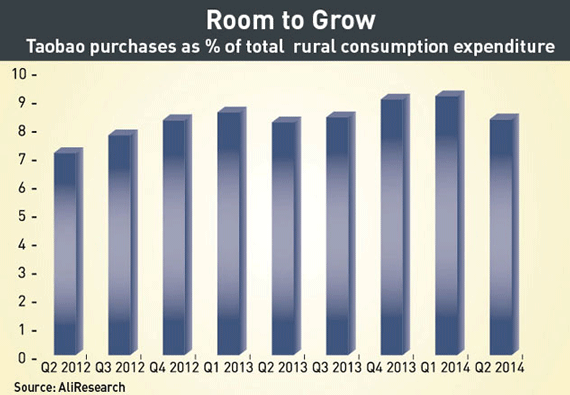
Chinese e-commerce companies like Alibaba and JD.com are finding a lucrative opportunity in rural areas. But what kind of strategies will work there?
The low-hanging fruit of China’s e-commerce industry, the urban market, is running its course, as consumers become savvier and competition becomes more intense. As these initial boom years recede, companies are looking to expand and innovate in order to consolidate their positions.
To that end, e-commerce giants Alibaba and JD.com have begun branching out to harder-to-reach markets, namely China’s rural areas. “Developing [these] is our first priority in the second half of this year,” Liu Qiandong, CEO of JD.com, said in a CCTV interview aired in November 2014.
Meanwhile, Alibaba Chairman, Jack Ma said, “Alibaba plans to expend a lot of energy in the entire field of rural ecommerce,” at a December 2014 event in Guangdong province. “We’re really hoping to bring e-commerce to all of China’s [many] villages, so that rural people can get a taste of the city life and sell their own products in the cities.”
The case for such a move is clear. A report from AliResearch, Alibaba Group’s research arm, released in October 2014 estimated sales from rural e-commerce would reach a value of RMB 180 billion ($29 billion) by the end of that year, and predicted that would increase to RMB 460 billion ($75 billion) by 2016.
That is not an insignificant portion of China’s total internet retail sales, which reached RMB 2.4 trillion ($390 billion) in 2013, and is predicted to reach RMB 3.3 trillion ($530 billion) in 2015, according to consulting firm, Bain & Co.
Alibaba’s Alipay Annual China Spending Report for 2013 also noted that consumption growth is gradually shifting from the country’s prosperous coastal regions to inland provinces. Additionally, the company’s first county-level economic and e-commerce forum held in May 2014 reported that e-commerce growth in counties and villages outpaced that in cities by 13.6 percentage points in 2013.
“This is one of the greatest growth areas in China,” says Teng Bingsheng, Associate Professor of Strategic Management at the Cheung Kong Graduate School of Business. “So for these big internet players to position themselves as early as possible does make sense.”
“China’s urban e-commerce industry is also saturated in terms of competition,” says Wang Rui, Assistant Marketing Professor at Peking University. “Big firms are dominating the market, like Alibaba and Jingdong (JD.com), so new players like Vip.com, Yihaodian and Tootoo are targeting niche markets,” she says.
Out in the Sticks?
Shen Haoyu, JD.com’s CEO of e-commerce business unit, was quoted by China Daily in July 2014 as saying consumers in small cities are active shoppers and the company had to act aggressively. He also noted that JD.com’s sales growth in third and fourth-tier cities already outpaced that in major cities.
These places feature heavily in discussions of Chinese rural e-commerce. “Usually when we look at the lower tier, we try to base it on the administrative classification. So they are typically the county-level towns, normally considered as lower-tier cities,” says Kunal Sinha, formerly the Chief Knowledge Officer and Regional Cultural Insights Director at international ad firm, Ogilvy & Mather. “Rural is not just farmers, but you also get a great number of people who are either in construction, mining or also the service economy.”
The classification of what is considered rural China is often a vague concept handed down from Maoist planners. It is relevant to note that although also classified as cities, lower-tier cities in China are more like towns in a conventional Western sense. Third and fourth-tier cities in China are more similar to large and small towns in more developed nations.
Marketing research firm, Millward Brown classifies third-tier cities as prefecture-level cities and fourth-tier cities as county cities. Of these, there are 238 cities with 32.4% internet penetration, and 388 cities with 27.7% internet penetration for third and fourth-tier cities, respectively.
At the end of 2010, only 20.1% of rural residents said they accessed the internet for online shopping, while 17% had used online payments. That low figure stemmed from low internet penetration rates in rural areas. By the end of 2010, users in rural areas had reached 124.8 million, according to the China Internet Network Information Center.
China had a total population of 1.35 billion people in 2012, with 47.4% of those living in rural areas, according to the 2013 China Statistical Yearbook by the National Bureau of Statistics. Meaning there is a rural market of 642 million people. Of those rural residents, 84.4% said they liked shopping online, according to the AliResearch report. The number equates to more than 542 million potential customers and retailers, and has skyrocketed in the last few years.
But there are numerous challenges.
Getting Online
Increasing internet connectivity is one. Telecom companies will effectively have to start from scratch, since these areas might not have the infrastructure already in place, which could constitute a huge investment.
Even more basic infrastructure is also lacking in some parts of rural China. Roads to ensure deliveries and other logistics; banks to facilitate online banking; and uninterrupted electricity sources to power computers and mobile phones, are not always in place.
“The infrastructure is different from a city’s. Internet access, mobile [ownership] are all lower,” says Wang.
Luckily, China’s largest tech companies have deep pockets—Alibaba has a massive war chest from their record-breaking IPO in late 2014. The company announced in October 2014 that it plans to invest RMB 10 billion ($1.63 billion) for infrastructure and logistics outside the country’s cities. It also plans on building “1,000 county-level service operation centers, create new services tailored to rural e-commerce, and to train retailers in rural areas, among others”.
In December 2014, JD.com also announced a partnership with the Grameen Trust, Nobel laureate Muhammad Yunus’ microcredit and social business initiative, to provide micro-loans for entrepreneurs in rural China. Micro-loans help those looking to start their own online stores, as items such as a computer, and insurance to be paid to platforms like Taobao, are unaffordable for most rural residents.
That’s in addition to another initiative, the JD.com Hometown Delivery Program, created to empower rural residents and establish better logistics in lower-tiered cities and the countryside.
“We’ve been leveraging our couriers, who often come from smaller cities, to expand in these areas [with the JD Hometown Delivery Program],” writes Josh Gartner, JD.com’s Senior Director of International Communications, in an email.
However, JD.com’s most important partnership is with Tencent, which owns a 15% stake in the company, and is China’s second-largest internet company by market capitalization. Tencent’s social apps, QQ and WeChat, which JD.com is now integrated into, increasingly act as entry points for a large number of mobile purchases as shopping platforms. In their earnings call in November 2014, JD.com’s Shen Haoyu said that most users of the two Tencent properties tended to be from lower-tier cities. He also said that mobile purchases made up 30% of all purchases in 2014 Q3.
The majority of lower-tier consumers’ spending goes into their basic necessities, according to Sinha. But patterns emerge with their first purchases the moment they have disposable income. “The first kind of purchases would be mobile phones because it allows them to stay connected with each other,” he explains. “And then there’s moving on to the comforts of home. ”
Convenience and choice are key points in the rise of e-commerce in lower-tier cities. Without the presence of large brands in physical locations, shoppers can access them, regardless of locale, and have them delivered, while at the same time comparing prices between brands.
“These markets have been traditionally underserved by brick and mortar retailers, so being able to get guaranteed authentic goods—including imported brands and food—quickly is a huge draw,” writes JD.com’s Gartner.
Another challenge is an intangible one: distrust in society. Chinese society’s level of trust does not rank highly compared to most countries, and yet the online marketplace is an industry that survives on trust.

“In rural areas you would expect more people to take cash on delivery,” says Sinha. It’s an option that some e-commerce sites like JD.com have that removes the hurdle of having to navigate an online banking account, and addresses trust issues—buyers can physically inspect the product before paying.
Additionally, online marketplaces have engineered mechanisms to help allay consumer fears through seven-day returns, the feedback system and guarantees about the authenticity of their products.
Reinventing the Village
Rural residents benefit from the technology and education that has come their way, developing the regions and boosting employment.
In fact, it has already begun with what has been dubbed as “Taobao villages”: traditional farming communities transformed thanks to new jobs created around Taobao, Alibaba’s largest e-commerce site.
AliResearch defines a Taobao village as a “cluster of rural e-tailers where at least 10% of village households engage in e-commerce or at least 100 online shops have been opened by villagers; and total annual e-commerce transaction volume in the village is at least RMB 10 million ($1.6 million).” According to AliResearch, the number of Taobao villages has grown tenfold from 20 at the end of 2013 to 211 at the end of 2014, and there are now some 70,000 Taobao village merchants. They also estimate that commercial activity from e-commerce provided 280,000 more jobs in rural China in 2014.
“E-commerce will help to close the gap a lot… these people can [now] not only get traditional jobs, or industry jobs based on urbanization, but they can also get internet-based jobs,” says Teng. “I think it will also create a lot of job opportunities, not to mention logistics [jobs].”
Tencent also launched a program called “Sending a Dream to the Countryside” in late November 2014, where it aims to build the first mobile internet village in China in Tongguan, Guizhou province. It partnered with China Telecom and phone manufacturer, ZTE to build a transmission tower and distribute smartphones. Training courses were also provided on how to use the phones to communicate and sell local specialties.
Jiang Yu, a 26-year-old junior village official, was assigned to a post in Bishan village in Anhui province in 2011. “After we got assigned to this village and got to know the villagers better, I realized that tourism didn’t help their financial situation,” she says in the 2014 documentary, Down to the Countryside. “So we wanted to find a way to help them have a better life.”
She and two colleagues helped villagers start an online store on Taobao, “The Young Village Official’s Farm,” which currently connects 27 farming households to customers all over China. Their online store sells local products like honey and preserved goods. “Now when I go to Bishan, I notice the villagers are happy,” Jiang says.
It’s also changing social attitudes in lower-tier cities, placing greater value on the goods it produces. It acts as a bridge, for instance, when farmers earn more when they can cut out the entire supply chain process and middlemen, going straight to urbanites concerned about food quality. “The biggest advantage is to link the rural areas with cities more closely,” says Teng.
No Revolution?
Although Suning, an electronics retailer, and Wanda, one of China’s largest companies, have joined in the rural e-commerce action, or announced plans to, some are skeptical there is even a trend worth noting. Anne Stevenson-Yang, co-founder and Research Director of J Capital Research, says she does not believe in the sudden relevance of going to the countryside.
“I’m not aware that it is a trend,” Stevenson-Yang says. “You could have said the same thing 10 years ago or 20 years ago as well and found plenty of signs. Chinese companies invest a lot of money when they list; it’s not a strategic thing.” Both Alibaba and JD.com listed to much fanfare in 2014, the same year their rural e-commerce initiatives became more prominent.
E-commerce will spread to lower-tier cities, but definitely not at the same speed as it did in the cities, according to Wang Rui. “Don’t expect the same fast growth. Urban markets had triple-digit growth when it boomed in 2010, and now are at about 30-40% base,” says Wang. “It will even probably have double-digit growth for the next 10 years,” she says of urban e-commerce.
“It does take a long time for e-commerce or a given segment to be ready for e-commerce,” says Teng Bingsheng. “For the rural area, I think the risk is that it’s not entirely ready. So if they move ahead of the curve, they might not see quick returns.”
Rural areas have weaknesses that may hobble tech companies’ push outside cities. For one, residents have much less spending power than their urban neighbors. Less spending power tends to drive out inhabitants, typically the younger generations, to the cities to seek better opportunities.
The drain of young blood in the countryside is a great threat to the burgeoning market. Contributing heavily to this is the country’s rapid rate of urbanization. In 2012, for the first time, the number of urban residents outnumbered their rural ones, according to China’s National Bureau of Statistics. Moreover, some of the areas rural e-commerce is being built to serve are literally disappearing.
“What people call urbanization in China is something quite different from what they mean by urbanization elsewhere,” says Stevenson-Yang.
“Urbanization in China is all about paving over rural areas. They’re not all about moving to cities, because… they’re not allowed to just move to cities,” she says, referring to China’s household registration system that limits internal migration.
It is also a priority for the country. “Urbanization is a national policy of the Chinese government, and it will continue to play a very significant role in the next 20 years or so,” says Teng. “So a lot of the people who now live in the countryside will be moved to small cities and townships.”
Down to the Countryside asks the fundamental question of whether China’s dying villages can be saved. It reports that in 2013, according to statistics from China’s Ministry of Civil Affairs, villages across China are disappearing at a rate of 300 a day.
Then there’s also the lack of regulation in online marketplaces. “With a kind of distributed production, what happens to quality control? Who is responsible for quality control?” asks Sinha. “Do small producers in the village have the knowhow to be able to keep quality at a certain level? On the consumer point of view, what kinds of assurances are there?”
Sinha believes online marketplaces cannot simply be a channel for these products. “The challenge is that in a lot of places, there are no unified and standard systems,” he says. “You heard in the past how there’s a national standard, and there’s a local standard and many producers say that they’re following local standards and then that’s fine.”
Increased competition from villagers in Taobao villages is also changing relations in rural areas as residents race to achieve a competitive advantage. In 2012 the Financial Times reported on one village in China’s eastern Jiangsu province where one man registered patents for his and other villagers’ products, sowing discord among his neighbors.
But given the cutthroat nature of e-commerce, it is understandable the e-commerce giants want to position themselves for wherever the e-commerce market might head. “I think this is really a move to be ready for the future,” says Teng.
And that means that even if it’s too early to call rural e-commerce a substantial trend, the companies involved are going to have to commit to the idea and stay the course given where it might lead.
However, Jack Ma sees a bigger picture. “We think that China’s economy will have undergone a fundamental change only when China’s rural areas become wealthy,” he said at the Guangdong event. “I want to say that what Alibaba is doing here isn’t a slogan or a stunt, it’s something genuine.”


















